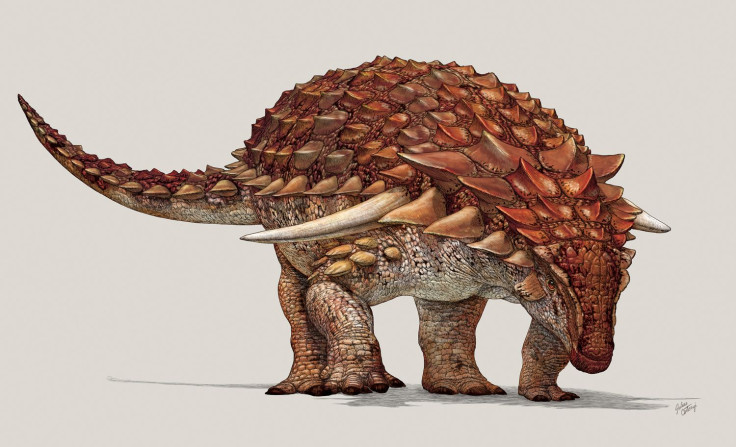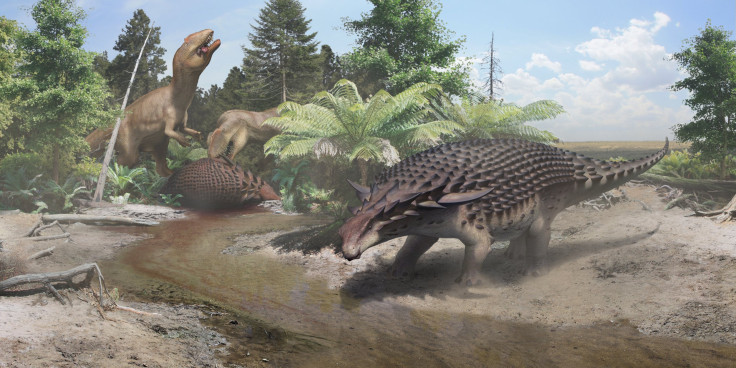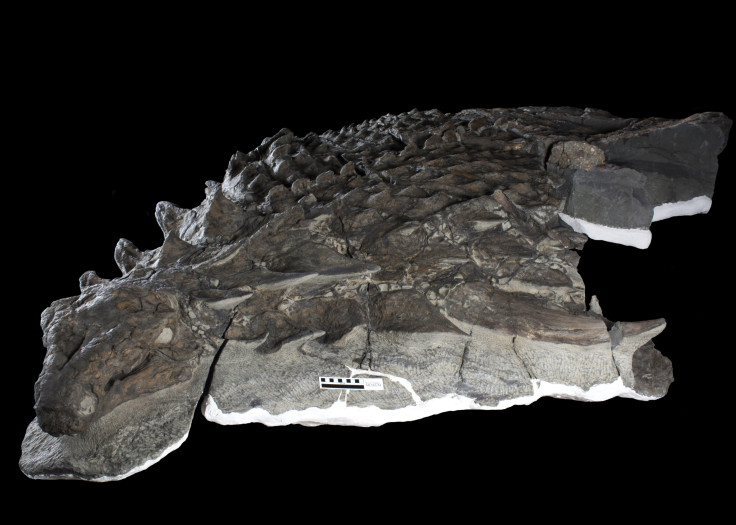Tank-Like Armored Dinosaur Borealopelta Markmitchelli Used Camouflage To Avoid Predators

It was 18 feet long and weighed more than 2,800 pounds, but its tank-like appearance and heavily armored body were not enough to ensure safety for a dinosaur that lived 110 million years ago. So, Borealopelta markmitchelli took to camouflage to avoid meat-eating dinosaur predators, researchers say in a paper published Thursday.
B. markmitchelli belonged to the nodosaur family of dinosaurs and its fossil, found accidentally in 2011 in a mine in Alberta, Canada, is exceptionally well-preserved, complete with a fully armored skin. The skin shows countershading, which even today is “a common form of camouflage in which an animal's underside is lighter than its back,” a statement from Cell Press, publisher of the journal where the study appeared Thursday, said. This suggests the nodosaur was likely a prey target of other carnivorous dinosaurs.

“Strong predation on a massive, heavily-armored dinosaur illustrates just how dangerous the dinosaur predators of the Cretaceous must have been,” Caleb Brown, lead author of the paper and a scientist at the Royal Tyrrell Museum of Palaeontology, where the specimen is now on display, said in the statement.
Read: 3D Technology Reveals Secrets Of Dinosaur Fossils
The researchers documented not just the pattern and shape of the scales and armor across the nodosaur’s body, but also inferred the pigmentation pattern of the skin using chemical analysis of organic compounds. B. markmitchelli had reddish-brown pigmented skin and countershading across its entire body, they inferred.
The analysis and conclusions of the research were made possible by the well-preserved state of the fossil, with researchers calling it “the best-preserved armored dinosaur ever found, and one of the best dinosaur specimens in the world.”
Brown elaborated and made a somewhat drastic comparison: “This nodosaur is truly remarkable in that it is completely covered in preserved scaly skin, yet is also preserved in three dimensions, retaining the original shape of the animal. The result is that the animal looks almost the same today as it did back in the Early Cretaceous. You don't need to use much imagination to reconstruct it; if you just squint your eyes a bit, you could almost believe it was sleeping... It will go down in science history as one of the most beautiful and best-preserved dinosaur specimens — the Mona Lisa of dinosaurs.”
Read: The Bite Of A T. Rex Could Crush 8,000 Pounds, Or Other Dinosaurs’ Bones
The species was named after Mark Mitchell, a technician at the museum, who spent over 6 years after the specimen’s arrival at the museum removing rock from around the fossil to reveal the dinosaur in all its glory.

A paper describing the dinosaur and its characteristics, titled “An Exceptionally Preserved Three-Dimensional Armored Dinosaur Reveal Insights into Coloration and Cretaceous Predator-Prey Dynamics,” was published online in the journal Current Biology.
Given the exceptional state of the B. markmitchelli fossil, the researchers expect many more studies to take place on the specimen in the Royal Tyrrell Museum, some by the same team and some by others. Brown’s team is currently trying to find out what this specific individual ate for its last meal, by analyzing the preserved contents of its gut.
© Copyright IBTimes 2024. All rights reserved.





















